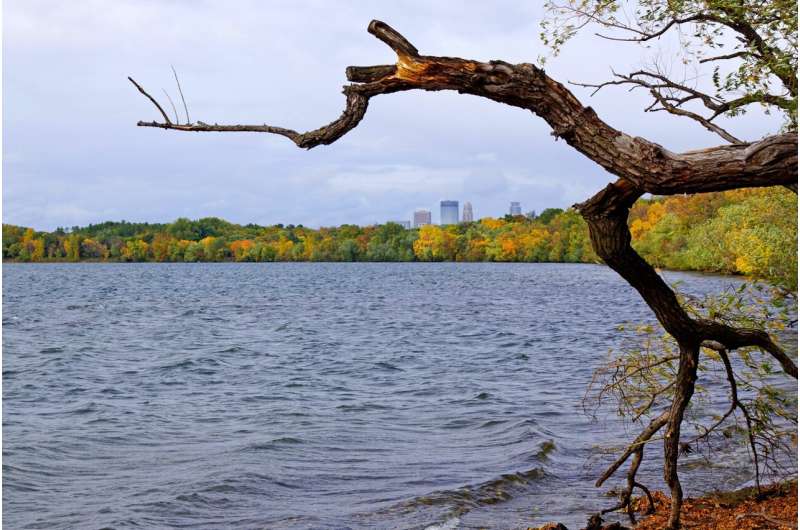This article has been reviewed according to Science X's editorial process and policies. Editors have highlighted the following attributes while ensuring the content's credibility:
fact-checked
reputable news agency
proofread
Minnesota lakes finally freezing over at latest dates on record

Organizers of the Art Shanty Projects, an annual art event on Lake Harriet, are pushing opening day back one weekend to Jan. 27 because there still was open water on Lake Harriet.
"Incoming subzero temperatures are giving us hope for a deep freeze," officials said Friday on social media. Sunday and Monday's temperatures—with highs hovering near zero before wind chill—will certainly help the cause.
It never has taken this long for the south Minneapolis lake to be fully covered with ice. It is joining a long list of lakes across the state—including Lake Minnetonka and Lake Waconia—that are freezing over at the latest dates ever.
"We will destroy the records that we know of for the latest ice-in dates," said Pete Boulay, assistant state climatologist. "We are adding a lot of data to lakes this year."
Tracking the ice-in and ice-out dates is a quintessentially Minnesota ritual with a big following, Boulay said. The Department of Natural Resources has been watching the annual occurrences then posting results online for decades with color-coded maps showing the dates the lakes freeze and thaw. It may be the only agency in the country to do so.
"There are some crowd-sourcing apps out there on social media that discuss lake ice, but I don't know of another statewide lake ice-in-and-out map," Boulay said.
But there's been no ice-in map this year. With this year's fickle start to winter—including a holiday heat wave—the agency has held off, citing safety concerns about thin ice and because some lakes that froze over early have shed their ice. But the map could be posted soon, Boulay said.
An official "ice-in" date occurs when a lake freezes over and remains ice-covered for the season, Boulay said.
"This has been a horrible year," Boulay said. "A lot froze over in November, then opened back up."
The DNR enlists citizen observers to report when lakes freeze over. Their reports do not measure ice thickness, only when a lake is covered, Boulay said.
Ice should be a minimum of 4 inches thick to support anyone on foot, 5 to 7 inches to support snowmobiles, 9 to 12 inches for a car and 13 to 17 inches for a truck, according to DNR recommendations. A man died on Lake Mille Lacs Friday after he and his truck went through ice about 6 inches thick.
"Ice is never 100% safe," the DNR said. "Ice conditions can change rapidly and should be checked frequently."
Until this year, Lake Harriet's latest ice-in date was Dec. 31, set in 2015. The earliest was Nov. 25, 1996, with an average ice-in date of Dec. 10 that is based on observations dating to nearly 60 years ago.
Ice can form about 1 inch for each day temperatures average 15° or lower. "It's not how many days below freezing at night," Boulay said.
The arctic blast is just what the doctor ordered for officials putting on the U.S. Pond Hockey Championships at Lake Nokomis. The south Minneapolis lake typically is frozen over by Dec. 1, but this year open water remained until ice finally formed just after New Year's Day. On Friday, the ice was 5 inches thick, tournament officials said, improving the odds that the tournament featuring 300 teams will start as scheduled on Jan. 18.
"We are extremely excited about this cold weather," said spokeswoman Kendall Vescio-Fassett. "We are probably the only people excited about it."
Lake Waconia in Carver County had the latest freeze-over date in the 80 years the DNR has been keeping track of ice-in dates. The lake froze over on Jan. 4, about five weeks later than normal and well past the previous latest ice-in date of Dec. 21, 1998.
Lake Minnetonka had yet to freeze over as of Friday, although bays on the Hennepin County lake have, Boulay said. Previously, Lake Minnetonka's latest freeze date was Jan. 2, 2002.
The DNR began creating ice maps in the 1970s when the Climatology Office tried to predict lake ice-out based on when the snow cover would disappear, Boulay said.
The DNR began creating ice-in maps primarily for climatological purposes, but they have acquired a following over the years, Boulay said.
"People want to know when lakes shed the ice so they can put in their docks and boats," Boulay said. "It's more dramatic when it leaves."
2024 StarTribune. Distributed by Tribune Content Agency, LLC.





















